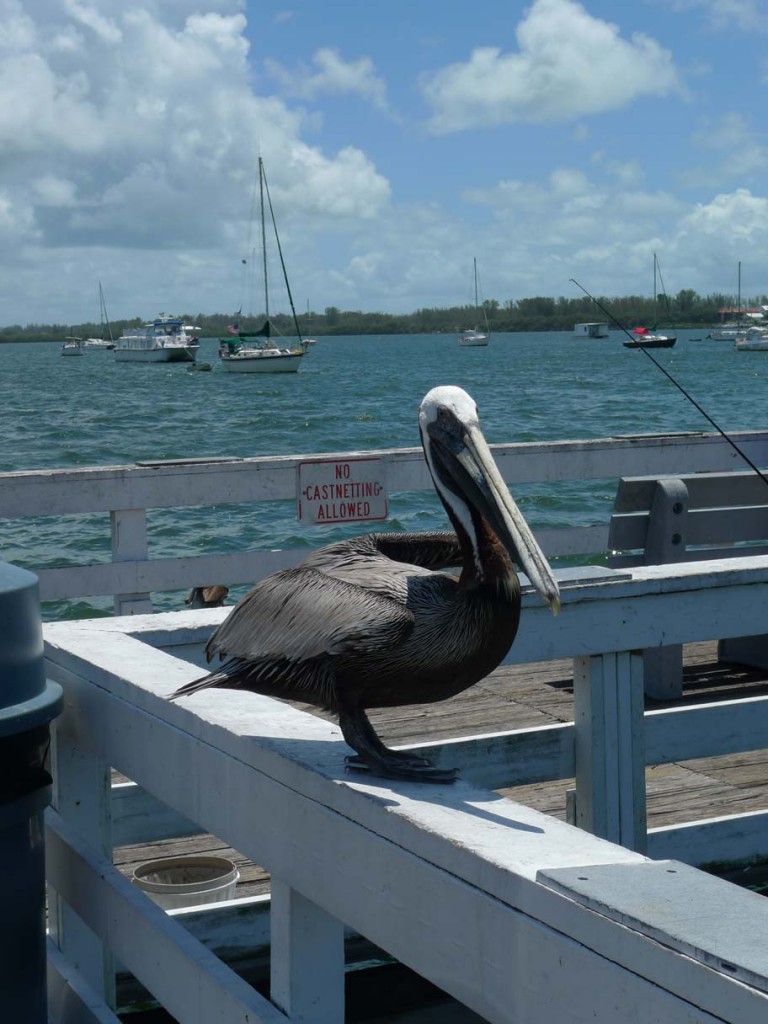
By: Alexandra Pratt
“What’s that?” says my husband Stuart, jumping up and pointing at the water. I look up from my ice cream, but all I can see in front of the boardwalk are dozens of small boats bobbing and dipping, their rigging clanking in the warm breeze
“There!”
This time a movement catches my eye and then I see it; a dolphin breaks the surface fifteen feet away, as he hunts for fish in the clear waters of the Gulf of Mexico.
We’re here for some much-needed winter sun, but as this encounter on our first day hints, there is much more to Florida than beaches and rollercoasters. It is full of the most incredible flora and fauna too – from alligators to orchids – and, as we discover, you don’t have to be an intrepid wildlife watcher to see it either!
We see the dolphin from Bradenton Beach Pier on Anna Maria Island, which is part of an historic district of weather boarded cottages built in the ‘old Floridian’ style. The area is popular for its Sunday markets, great fishing (for men and pelicans, as well as dolphins) and miles of white sand beaches.
Anna Maria is the northernmost link in a chain of barrier islands just offshore from the city of Sarasota. These islands boast some of the most exclusive residences in the area, but they’re also popular for all kinds of water sports, from sailing to scuba diving, as well as more genteel activities like shelling or bird watching. We’re disappointed this is the wrong time of year to see the endangered loggerhead turtles that migrate here to nest each spring. The famous beaches become their territory then, and it’s illegal even to burn a light on the beach after dark.
Bizarrely perhaps, some of the first cottages on the island were built by circus workers in the 1920’s. These people were here because the property tycoon and circus owner John Ringling used to winter here on his 66 acre estate. This is our next stop, and it’s certainly a fascinating glimpse into a world reminiscent of F. Scott Fitzgerald’s The Great Gatsby. Ringling and his wife Mabel were keen travellers, and they amassed an art collection that would put many smaller European capital cities to shame.
The collection is open to the public, but elsewhere on the estate is also a circus museum, a theatre, and Ringling’s Venetian Gothic mansion on the waterfront, called Ca’d’Zan. This opulent house may be filled with painted ceilings and solid marble bathtubs, but I’m drawn to the huge and aromatic rose garden – all 27,000 square feet of it – planted by Mabel in 1913. While none of her own plants survive, the 1200 rose bushes in this Italianate circular garden are, justifiably I think, regarded as the finest public collection in the USA.
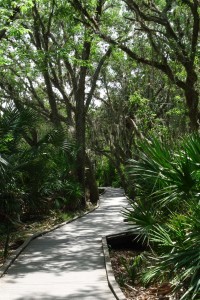
A little further around Sarasota Bay is the Selby Botanical Garden. Home to another important collection, the garden boasts 6,000 orchids, many of which are on display in the conservatory, which has the humid, dripping atmosphere of a rainforest. I’m relieved to step into the fresh breeze outside and explore the other speciality areas; for hibiscus, succulents, epiphytes and even a tropical food garden. It is 9 acres of treasures in miniature. Until, that is, we find the banyan grove.
“It says here Alexander the Great sheltered his army of 7,000 men under a banyan tree.” Reads Stuart out loud. We look up. It’s huge, sure… but a whole army?
Stuart has yet to see an alligator however, so we drive out to the Myakka State Park, about 20 minutes south of Sarasota. Formed around the Myakka River and two lakes, the park is 58 square miles of preserved wetlands, prairie and woodland. Its home to all kinds of rare animals such as bobcats, armadillos, panthers and gopher tortoises, and we follow a winding drive through trees draped in Spanish moss to the largest of the lakes, hoping for a sighting.
There is an airboat tour here, but we prefer a less noisy way to see nature and opt instead for one of several boardwalks along the shoreline. The bobcats are elusive, but the birdlife is extraordinary and we indentify, with the help of some information boards, herons, ibis, woodstork, egret…Then, there’s a bit of a commotion among the handful of visitors nearby.
“A bald eagle!” a lady cries. There is a mass fumbling for binoculars and we look helplessly at each other. How did we manage to leave those behind? Then, a very kind lady slips a quarter into the viewfinder (we only have dollar bills) and the emperor of the American skies slides into focus. He’s standing on the ground, sun glinting off that distinctive white ruff and curved yellow beak. Even from this distance, he looks about the size of a Rottweiler.
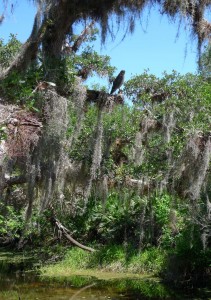
We have the rest of the park virtually to ourselves, as we hike off on one of the many trails. The changes between habitats are clear and unusual; one minute we’re shaded by pine trees, the next we skipping across bog! Black feral pigs scoot across our path; a line of adorable piglets behind a very rotund Mama. Later, we see a red-shouldered hawk in an oak-palm, eyes dissecting the same ground stalked by a heron below. There are still no alligators though, until we are leaving, when suddenly we spy five, lying innocently along the banks of the river with their mouths open, basking in the hot sun.
It is possible to hire a canoe inside the park, but I disappoint Stuart by refusing to paddle past these toothy predators with only a plastic boat for protection! Out on Sanibel Island however, the salt seawater in the JN Ding National Wildlife Refuge means there are no alligators, and we can paddle in safety. A well marked route takes us through tangled mangroves; tunnels of greenery where herons flap away in alarm, and across open inlets, where huge fish – mullet, we learn later – jump clear out of the water. Some are so close, I’m worried they will land inside our kayak!
The most amazing sight however, is an osprey, sitting quietly in a tree just above us. He’s clearly unconcerned at being a celebrity as we glide past, taking photos. These birds are fairly common in Florida’s waterways but never fail to excite visitors from the UK, who are more accustomed to sitting for hours in Scottish drizzle for a single glimpse!
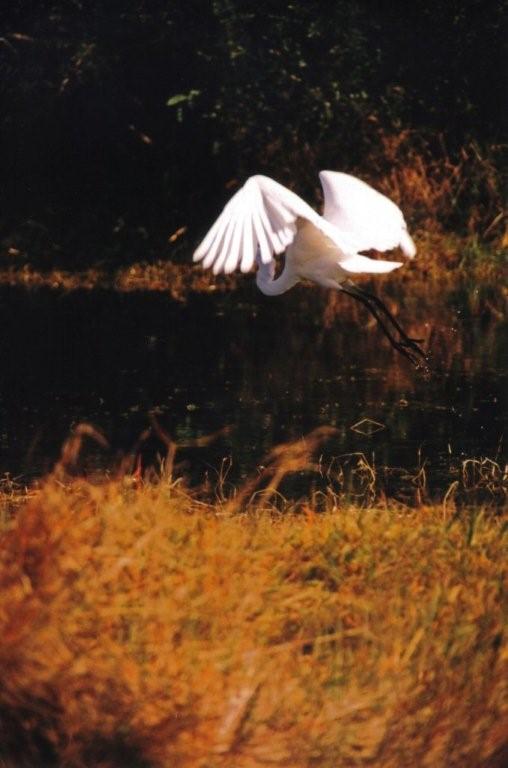
It’s the next day however, when we visit the achingly fashionable Siesta Key – home to America’s ‘No. 1 beach’ and many luxurious homes – that we see the osprey in action. Astonishingly, there is another, small wildlife preserve among some small mangrove islets here and so we paddle the channels; millionaires homes on one side, dense green islands on the other. And it’s here, as we pause, floating on water as clear and still as a mirror, that we watch an osprey hunting for food, diving again and again into the water barely 50 yards away.
Eventually, he wheels away, dinner glistening in his talons, and we paddle quietly off so he can dine in peace. We pull the kayaks ashore on a little sand bluff that separates the islands’ intracoastal waterway from the Gulf beyond, and lie back in the sun. This may not be the nation’s No1 beach, but it’s paradise to us.
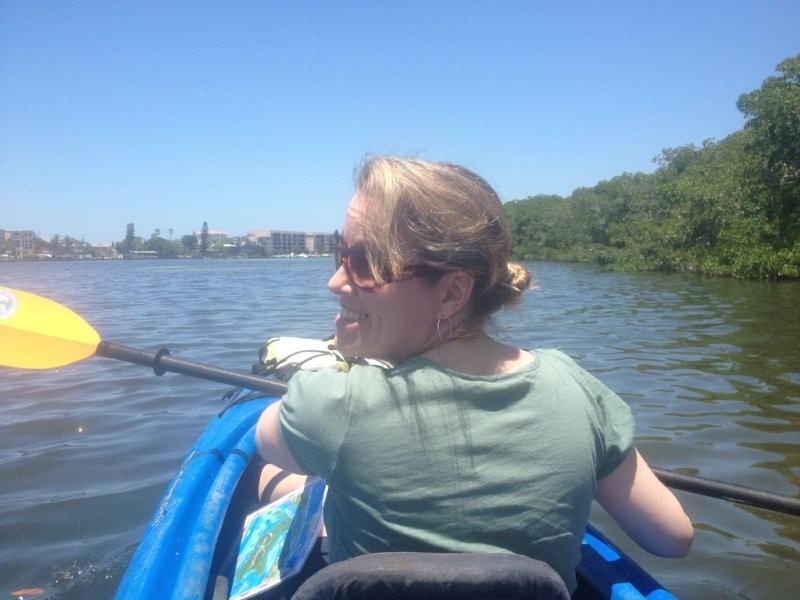

I always think of Florida as a bland, tropical suburbia, and tend to forget it has wildlife. Thank you for this very interesting look at another side of Florida that isn’t all about soaking up the sun in a lawn chair, nightly entertainment spots and dizzying roller coaster rides.